Home (amp tone and effects placement)
Books about Getting Guitar Sounds
These are books and videos that instruct guitarists how to hook-up guitar gear and use guitar gear to dial-in, emulate, and reproduce desired sounds.
Todo: remove separate pages on amps, effects, recording, confirming that all items are listed here, to reduce maintenance time.
Related Lists
Book list at Amazon.com - Getting Electric Guitar Sounds
Books and videos about guitar amps
-- guitar amp history and design, not usage
Books and videos about guitar effects -- general
use of effects for instruments, effects design, not about usage of guitar
effects processing
Books and videos about recording in pro and home studios -- not specific to guitar
Contents
Amp
Tone: How to Dial-in Any Guitar Amp Sound at Any Volume
Advanced
Techniques for Modern Guitar Amp Design
Guitar
Gear 411: Guitar Tech to the Stars Answers Your Gear Questions
Guitar
Effects Pedals: The Practical Handbook.
Guitar
Rigs: Classic Guitar and Amp Combinations
The
Guitar Amp Handbook: Understanding Amplifiers and Getting Great Sounds
The
Electric Guitar Sourcebook: How to Find the Sounds You Like
The
Complete Studio Guitarist: The Guitarist's Guide to Session Work and Studio
Recording
Sound
Advice on Recording and Mixing Guitars.
Wired:
Musicians' Home Studios: Tools and Techniques of the Musical Mavericks
DVD
about recording the guitar (loaned out)
Tube
Guitar Amplifier Essentials
Guitar
in the Studio (videotape)
Crash
Course on Guitar Effects
Electric
Guitar Amplifier Handbook, 4th Ed.
Guitar
Gear (A Guitar Player book)
Tube
Guitar Amplifier Servicing & Overhaul (DVD)
Analog
Man's Guide to Vintage Effects (print book)
Keep
the Peace!� The Musician's Guide to
Soundproofing
The
Complete Effects Guide (.pdf book)
How
to Modify Your Own Effect Pedals (.pdf book)
How
to Modify Guitar Pedals: A Step by Step Guide (printed book)
How
to Modify Your Own Amplifier: A Step by Step Guide
Getting
Guitar Sounds Using Amps with Effects.
Gear
Secrets of the Guitar Legends: How to Sound Like Your Favorite Players (book
with CD)
Amp
Basics (Peavey Answer Book Series) (book)
Getting
the Sounds: Classic Rock Guitar (videotape)
Guitar
and Amp Tone Video (RPM) (videotape and book)
The
Bonehead's Guide to Amps (book)
Recording
Guitar and Bass: Getting a Great Sound Every Time You Record (book with CD)
Recording
Guitars & Guitar Sounds (cassette)
Recording
the Electric Guitar: It's All About Tone (book with CD)
Recording
the Guitar: Get a Great Sound Onto Tape (book)
The
Recording Guitarist: A Guide for Home and Studio (book)
Using
Guitar Effects (in Isolation from Amp Tone)
100
Superstar Guitar Sounds on a Stompbox Budget (DOD Presents) (book with CD)
BOSS
Compact Pedal Application Video (videotape)
BOSS
Compact Pedal CD (CD-ROM)
BOSS
GT-3 Demonstration Video (videotape)
Effects
and Settings: A Complete Guide to Getting the Best Sounds from Your Effects
Equipment (book)
Getting
the Sounds: Classic Guitar Effects (video or DVD)
Guitar
Effects Guide Book (BOSS) (book with CD)
Guitar
Player Oct 1992: The Distortion Issue (magazine)
The
Bonehead's Guide to Effects (book)
Playing
Techniques Supplemented with Gear
60s
Psychedelic Guitar (videotape with insert)
Get
that Classic Fender Sound! (videotape with insert)
Getting
the Sounds: Classic Blues Guitar (videotape)
Getting
the Sounds: Classic Country Guitar (videotape)
Getting
the Sounds: Hot Nashville (DVD)
Painting
With Guitar (videotapes)
The
Guitar F/X Cookbook (book with CD)
The
Guitar F/X Cookbook (videotape with insert)
Tricks
and Special Effects (book with CD)
Book
Coverage Needed about Using Guitar Gear to Dial-in Amp Tone
Index
Entries/Glossary Entries:
Amp Tone: How to Dial-in Any Guitar Amp Sound at Any Volume
This book doesn't exist; it's what I want to write, per my book outline at the bottom of this page. � Michael Hoffman, Amptone.com
Advanced Techniques for Modern Guitar Amp Design
by Kevin O'Connor
- Power Scaling: history and technology, implementing multiple Power Scale controls, how to install into existing equipment.
- Super Scaling, with both fixed and variable boost ratios, using both solid-state and tube methods, for large-amp-loudness with small-amp-tone.
- Power Management: AC and DC current limiting, voltage restoration, voltage clamping, sag control systems both active and passive, and composite zener circuit applications � a recent trend in tube amp biasing. Mains noise abatement and line adjustment
http://www.londonpower.com/books/tut4.htm
Power Press Publishing
2006
$100
I don't have this.
Guitar Gear 411: Guitar Tech to the Stars Answers Your Gear Questions
by Matthew Bruck
Q and A format. Mathew Bruck is Eddie Van Halen's guitar tech.� Guitars, amps, effects, tone, accessories.
http://www.alfred.com/span_webcat/item_detail.cfm?pub=0&item=0763B � official book page
http://www.google.com/search?hl=en&q=%22Guitar+Gear+411%22+bruck -- search
Diagrams, technical drawings, and photos. 96 pages. 2005
I have this. �Worth getting.
ToneFest Reports and Demo CDs
ToneFest.com -- will offer CDs and reports of amps and effects from these large-scale get-togethers.
I don't have this.
Guitar Effects Pedals: The Practical Handbook
by
Dave Hunter
0879308060
July 2004
I have this.� Worth getting.
Guitar Rigs: Classic Guitar and Amp Combinations
by
Dave Hunter
0879308516
April 2005
I have this.� Worth getting.
The Guitar Amp Handbook: Understanding Amplifiers and Getting Great Sounds
by
Dave Hunter
087930863X
Oct. 2005
I have this.� Worth getting.
The Electric Guitar Sourcebook: How to Find the Sounds You Like
by
Dave Hunter
0879308869
May 2006
Introduction to Guitar Tone and Effects: A Manual for Getting the Sounds from Electric Guitars, Amplifiers, Effects Pedals and Processors
by David M. Brewster
http://www.amazon.com/gp/product/0634060465/
Aug 2003
I have this.� Worth getting.
The Complete Studio Guitarist: The Guitarist's Guide to Session Work and Studio Recording
by Vivian Clement
http://www.amazon.com/gp/product/0739035363
96 pp
2004
The jam-along CD doesn't seem useful, compared to others.
I have this.� Worth getting.
Sound Advice on Recording and Mixing Guitars
by Bill A. Gibson
http://www.amazon.com/gp/product/1931140383/
May 2004
I have this.� Not bad, not the very best, because fairly short.
Wired: Musicians' Home Studios: Tools and Techniques of the Musical Mavericks
by Megan Perry
Wired� Musicians' Home Studios � perry - rec, sounds
http://www.amazon.com/gp/product/0879307943/
Sep. 2004
I have this.� Worth getting.� Several artists report using an isolation booth with remote miked cab in their home studio.
DVD about recording the guitar (loaned out)
Todo: Add when receive it back.
I have this.� Worth getting, after getting the best of the related books.
Tube Guitar Amplifier Essentials
by Gerald Weber
The book has 528 pages of all new material
not found in Gerald's other books. It has tons of information. More than 60
chapters. There's a section on Getting the Most from your amp, Non-Technical
Tips for the Guitarist, Speakers, Tubes, Transformers, Rectifiers,
Troubleshooting and Repair, Modifications, Amp Building, Capacitors, Biasing,
Power Attenuation and a couple of hundred pages of Questions and Answers. The
Q&A is sectioned off into Fender, Gibson,
http://musicbooksplus.com/tube-guitar-amplifier-essentials-p-6681.html
http://www.amazon.com/gp/product/0964106027/
$34.95�����
Dec. 2005
I don't have this.
Guitar in the Studio (videotape)
by Dan Huff
Huff
was a session guitarist who worked for artists including Faith Hill, Lonestar,
SheDaisy, Madonna, and Michael Jackson.�
Producer in
http://www.google.com/search?hl=en&q=%22Guitar+in+the+Studio%22+%22Dan+Huff%22
2002
$34.95
I have this but haven't watched it yet � TODO: review.
Crash Course on Guitar Effects
by Joe Bennett.
Beginner's
guide.� How effects pedals work; how to
use distortion, chorus, compression, delay, reverb, wah-wah and other effects;
how to combine effects; multi-effects units and how to use them; getting the
most out of your gear. The CD features over 50 demo tracks, sample settings and
FX do's and don'ts. Many photos and diagrams.
The Essential Guide for All Guitarists. Guitar Educational. Book & CD Package. 9x12 inches. 32 pages. Published by Artemis Editions. (HL.00695813)
http://www.amazon.co.uk/gp/product/1904411169/
http://www.google.com/search?hl=en&q=%22Crash+Course+on+Guitar+Effects%22+bennett � search
June
2004
Publisher
: Artemis Music Ltd
ISBN
1904411169
�7.99
I don't have this.
Electric Guitar Amplifier Handbook, 4th Ed.
by Jack Darr
Covers amplifying the signal; special signal circuits; the power supply; the amplifier signal circuits; the power supply; output stage-transformers and speakers; cables and pickups; customer complaints; small and medium power amplifiers, preamplifiers, and special effects devices - schematics; high-power amplifiers - schematics; super-power amplifiers � schematics.
New reprint of the 4th edition of this book, originally published in 1973. Contains three sections-'How Guitar Amplifiers Work,' 'Service Procedures and Techniques,' and 'Commercial Instrument Amplifiers.' Everything you need to know about how each part of the amp works and what to do about it if it doesn't work. The final section of the Handbook is full of schematics for many of the guitar amplifiers in use at the time including models from Ampeg, Bogen, Baldwin, Fender, Gibson, Gretsch, and others. Line drawings and photos.
2006, 1973, 384pp., softbound
ISBN 1-882580-48-6
$29.95
http://www.evatco.com.au/books2.htm
http://www.audioxpress.com/bksprods/books/bkaa69.htm
I don't have this.
Guitar Gear (A Guitar Player book)
by John Brosh (Editor)
http://www.amazon.com/gp/product/0688031080/
May 1985
I have this.
Tube Guitar Amplifier Servicing & Overhaul (DVD)
by Gerald Weber
Kendrick Amplifier President and Vintage Guitar magazine columnist Gerald Weber has overhauled and restored over 15,000 vintage tube guitar amps. This extensive DVD covers: basics of servicing and overhauling a tube guitar amp, what tools are needed, the wiring mistake made on 50% of all amps and how to correct it, the best way to straighten preamp tube pins, how to perform a cap job correctly, the different types of Silverface amps and how to convert each to Blackface, how to identify leads of an unknown transformer, how to make perfect chassis grounds, and much, much more! Nearly four hours. �2005, DVD.
http://musicbooksplus.com/tube-guitar-amplifier-servicing-overhaul-p-6680.html
$69.95
ISBN: 1423409973
Analog Man's Guide to Vintage Effects (print book)
http://www.formusiciansonly.com/analog.html�
I don't have this.
Keep the Peace!� The Musician's Guide to Soundproofing
by Mark Parsons
http://www.amazon.com/gp/product/0634089048/
Oct. 2005
I have this.� Worth getting if you do room construction.
The Complete Effects Guide (.pdf book)
by Brian Wampler
$15
Misleadingly and incorrectly shown as "Better Guitar Tone!"� The author is hazy and inconsistent on what most of his book titles and cover art are.
Like Craig Anderton, Brian Wampler is essentially an fx guy, not an amp or amp tone guy, thus advanced users will find the advice too limited.� This .pdf is overpriced in terms of cost per page, per word, per picture, or per clip, compared to the printed books, and the usefulness of its advice is average among the books.
The formatting is subpar.� The page breaking is poorer than shown at the site, even though it is a .pdf.� It needs a proper pass by an editor.� It's an unpolished, causally slapped-together affair.
I have this.� TODO: read it more, then review.
How to Modify Your Own Effect Pedals (.pdf book)
by Brian Wampler
I don't have this.
How to Modify Guitar Pedals: A Step by Step Guide (printed book)
by Brian Wampler
He's hazy and inconsistent on what most of his book titles and cover art are, so this might be same item as above.
I don't have this.
How to Modify Your Own Amplifier: A Step by Step Guide
by Brian Wampler
I don't have this.
FAQ: Recording the Guitar
by Phil Gates
http://www.amazon.com/gp/product/0786635975/
Oct. 2005
$5
Badly
needs an edit pass � I'm surprised
I've
asked the book editors at
I have this.
Gear Secrets of the Guitar Legends: How to Sound Like Your Favorite Players (book with CD)
Pete Prown, Lisa Sharken. Paperback: 120 pages. Publisher: Backbeat Books; ; Book and CD edition (June 2003). ISBN: 087930751X. Amazon.
I have this. � mh
Review � updated July 30, 2006
Fake CD contradicts the spirit of the title
The book is superficial and somewhat disappointing; for example it is confusing and unhelpful in Van Halen's signal path.� Dave Hunter's books are closer to what's needed.� This book is ok to add to a collection, but not the first book to get.
The accompanying CD sounds bad. After gathering articles about genuine star guitar rigs, one editor poured his time and energy into making a so-called sample CD -- using an amp simulator.� The CD tracks provide fake, incomplete, half-baked Tone at best. It misleads and misguides beginning guitarists to make them think that this non-range of non-Tone is worth recording.� These tone samples are mediocre at best; instead, Dave Hunter's CDs with his good books set a proper standard.
Why would anyone ever choose to listen to this fake sound when they could easily put on a genuine, rich sounding record instead? It's misguided to use the opposite of Tone, to create a CD that is marketed as showcasing the goal amp sounds, including actual power tubes and bona fide speaker distortion, which are explained to some extent within the book.
What this CD ends up demonstrating is negative: why your tone is doomed to sound like a total uninspired amateur and poseur if you use an amp simulator rather than actual power tubes and hard-pushed guitar speaker. The CD perpetuates the divide between kids' gear and adult gear (per the Damage Control founders who broke off from Line 6 corporation).� Actual cranked amps are essential to the qualifications of the guitar gods.
This sample CD could be a boon to amp tone, by steering people away from amp simulators, jolting some good sense into them to run out and get instead an actual miked-amp setup, such as a tube power amp and a guitar speaker, possibly in an isolation booth.
- mh
Getting Great Guitar Sounds: A Non-Technical Approach to Shaping Your Personal Sound, Second Edition (book)
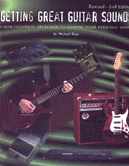
Michael Ross. 1998. 80 pages. $14.95. Developing, controlling and shaping your own personal guitar sound. Various principles of sound in acoustic and electric guitars. Multieffects units, amp simulators, and advanced effects rigs. Many artists are included in the "How Did They Get That Sound?" section, such as Robben Ford, Eric Johnson and David Torn. Ross lists his favorite effects units and tells why they will provide most of the sounds guitarists will need. Music Books Plus Amazon.
I have this. -mh
Review
This book is well conceived in general scope, with the right audience, right goals, and appropriate mix of effects and amp integration. It is lacking in coverage of some key points within that scope, however.
The active pickups coverage on p. 27 & 29 doesn't say anything about how pre-distortion EQ, or pickup response, affects the preamp distortion voicing.
On pages 30 & 32, it fleetingly touches on the importance of power-tube distortion, and approaches to managing the loudness problem: "Some of the best sound comes from overdriving the power stage of a tube amplifier..." "...the sound of power tubes breaking up... How can I get that sound without losing hearing/getting fired/blowing up the amp?"
Page 33 uses the term "power-soak". That's an error; the expression should be either "power attenuator" or "Scholz Power Soak". It's a decent paragraph, but helplessly states you can't get a loud clean sound, instead be prodding designers to make stompbox controls for power attenuators, a trivial technological problem. When it comes to power attenuators, this author, like the whole industry, mentally wimps out instead of solving this simple problem.
On the same page, it talks about cranking small tube amps, and employing "load resistors" -- that expression is incorrectly used; it should say more generally, "dummy loads". A THD Hot Plate, for example, can't be described accurately as a "load resistor". It says such loads are "unrivaled for tone production", but that's incorrect (as well as unclear what the author is proposing); for most sounds, better sound with more dynamic complexity is produced through power tubes and output transformer directly pushing a guitar speaker.
Page 61 mentions using "low enough wattage [tube amps] to get some power tube breakup at reasonable volume".
Page 63 mentions baffles (also known as gobo's, for go-between sound barriers), the loudness and isolation and 2-way leakage problem, the Tech 21 SansAmp analog guitar amp simulator, and the difficulty of capturing sound via mics. Page 64 mentions the Groove Tubes Speaker Emulator II.
The recording section is too short, at only two pages. Fortunately there are at present four books specifically about recording the electric guitar. It has only two pages of coverage of capturing a guitar sound via microphones or direct-injection into the mixer.
Mentions David Torn's video "Painting with Guitar", in the "How Did They Get That Sound" section.
There's a typical half-intelligent mention of distortion voicing via the interaction of EQ and distortion: the tone controls on the amp and guitar cause a "distinct change in the type of distortion" (p. 41). That's better than saying "the sound changes", but really not much more helpful or insightful. What does boosting/cutting bass/treble before/after the preamp/power amp/speaker sound like? How do you decide at which stage to boost/cut a frequency? The books halt miles before these questions.
What's the purpose of talking about guitar effects in isolation from each other and from the amp? Anyone can hear individual effects in any guitar store -- meanwhile, we're left without a clue about how to bend amp tone itself through controlling eq and levels at multiple distortion stages from guitar pickups to studio monitors -- which is exactly what this book should, and doesn't, cover. It covers some aspects of "getting great guitar sounds", but is limited as far as "getting great amp and distortion sounds".
At this point, there aren't enough books on getting guitar sounds to be very critical; we have to buy what's available and try to piece together the clues. This book is the most well-conceived book, though there's much room for improvement in content. Recommended, because it has the right goal, though there's ample room for improvement.
- mh
Getting Great Guitar Sounds: A Non-Technical Approach to Developing, Controlling, and Shaping Your Own Personal Sound, First Edition (book)
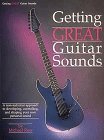
Michael Ross. $10.95. 1988. 63 pages. ISBN: 0793591406. Developing, controlling and shaping your own personal guitar sound. Various principles of sound in acoustic and electric guitars. Music Books Plus. Amazon
I don't have this; I have the 2nd edition. -mh
Getting Your Sound: The Player's Guide to Guitars, Amps, and Effects - The Guitar Shop Series (book with CD)
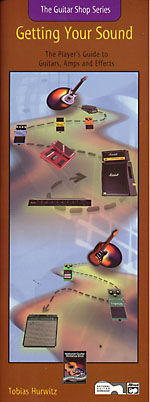
Tobias Hurwitz. How do your favorite guitarists get their sounds? Learn the setup secrets of the masters and find your own great sound with this 56-page manual for serious guitarists. Read about guitars, amplifiers and effects units and how to make your own gear work its best. Each effect is covered in depth, and a special section details the setups of the masters, suggesting ways to recreate their sounds with basic effects available anywhere. A special section on the physics of sound is included. This is a must for every electric guitarist. The included CD demonstrates all the guitars, amps, effects and master guitarists' setups. 1998 or Feb 2000, 56 pages. Book & CD. -- $15.95. ISBN 0-88284-956-5. Music Books Plus. Barnes & Noble. National Guitar Workshop.
I have this. - mh
Review
CD -- each section in the booklet has a number indicating the CD sample of the effect - nice.
Power attenuator coverage? Yes. Has an entry "Artificial Loads: Power Soak, Hot Plate, etc.", unlike most "effects" lists, and Hot Plate sample is on the CD, track 41. Accolades for having an actual section heading for this subject, with a whole paragraph and rudimentary diagram. The heading should say "dummy loads and power attenuators", not the untechnical neologism "artificial loads". The author uses "power soak or power break" generically in the paragraph, which is a bad idea because "Power Soak" and "Power Brake" are names of a particular product and should be capitalized, and the technical, correct term is "power attenuator", which incorporates a "dummy load", which may be a "resistive load" or a "reactive load". The author repeats the misspelled and miscapitalized term as "power break" in the paragraph and "POWER BREAK" in the diagram. Doesn't describe the pros and cons of competing products, which would be helpful -- such as loss of bass and treble with the Scholz Power Soak, and the largely improved (yet still very improvable) THD Hot Plate which has some limited tone control and a sweeter, less dull inherent response. On the CD, he calls it the "THD Hot Plate dummy load" -- that's incorrect; it's a power attenuator; a power attenuator consists of a wattage splitter and internal dummy load. Generally, you can use a power attenuator as a dummy load by setting the wattage splitter to route all power to the internal dummy load, and taking a line-level signal from the speaker output or padded output.
Page 15 has some implicit coverage of pre-distortion EQ, in that it mentions active pickups as EQ. The "Equalizers" section equates guitar's tone knob with an eq pedal, but doesn't mention distortion voicing, and doesn't explicitly say to put EQ before distortion; in fact, all the diagrams always show EQ after distortion, never before.
Page 20 cover speaker distortion; the "Cones" section mentions degree of speaker distortion with lower wattage speakers.
The coverage of Van Halen obsesses, as usual, on the Variac, while failing to mention Eddie's dummy load or the pre-dist eq or the post-power-tube eq. It's amusing to read about the "miracle" and "mystery" of the Van Halen sound. I hold that the Variac was a decoy diverting attention from the *key* points in the chain: multiple EQ stages and load resistor; the Variac's real function was largely about preventing wearing out the power tubes, rather than adding something to the Tone.
Track
52 on the CD (Hendrix: Wah, Fuzz,
It's hard to get a good miked sound. The Hendrix and Metallica sounds on CD are good, but the Van Halen and SRV and Randy R. simulations were amateurish -- no better than a typical beginning bedroom guitarist. They sounded to me like anyone with a couple pedals into an amp at bedroom level -- pedestrian, ordinary, fakely processed, "beginning guitarist in music store" sound. Still, the booklet/CD is strong, even if the manual amp modelling wasn't the best. It was a great idea in these tracks to produce each sound with real amps and then done with effects pedals into the mixer.
Note that Wah is usually described as a form of EQ, but why do the textbooks always put wah *before* distortion, but always put EQ *after* distortion? If Wah before distortion, including the half-cocked wah technique is such a good idea, then why isn't EQ before distortion also given serious consideration?
Like the book "Getting Great Guitar Sounds", has a well-conceived focus than spans, and to some extent integrates, guitar, effects, and amp gear usage.
Page 15 bottom covers active pickups -- "for discriminating players who demand total control of their sound", but doesn't clarify how to use eq-pickups to control and dial-in distortion tone, such as how to use it to model an album sound and how to decide which pickup to use. Speaker distortion is briefly but usefully touched on, p 20. Typical near-useless, and obvious, discussion of EQ p 28 - "allows for powerful tone shaping and/or a clean volume boost", but so much more needs to be said in the context of pre-distortion eq, where a "volume boost" acts as distortion gain boost, both overall and per-band.
Page 47 shows an EQ pedal placed before a distortion pedal, for Randy Rhoads, with a frown curve. It's rare to see this "secret" spelled out.
I like how the guitar demos starting the CD are played clean and distorted. Too often, demonstrators assume that a clean sound is better for hearing the guitar, though most tone seekers focus on distortion sounds.
Like pretty much all these books, it is good for laying out all the conventional common knowledge about guitar gear, but it lacks just those tips that are so missing from common knowledge, such as systematic and practical theory of pre-distortion EQ throughout a system.
Recommended, because it has the right goal, though there's ample room for improvement.
- mh
Amp Basics (Peavey Answer Book Series) (book)
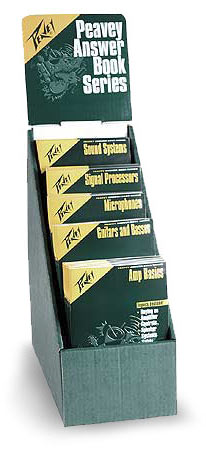
Tucker, Jim. Paperback. Hal Leonard
Corporation.
I have this.
Review
Short, but very good, well focused and well conceived; to the point. Examples drawn from Peavey products, but written so concepts are brand-independent.
Unusual, detailed coverage of grounding and checking for shocks during gig setup.
Intelligent and practical description of speaker distortion, p. 21; "some like this, some don't" p. 22.
Correct, important, but vague mention that tone controls on the amp affect "the attack of the amp", p. 6.
Intelligent remark about "the sound of speakers worked hard... blown speaker", p31.
Typically short but intelligent and accurate mention of power attenuators, p.11. Speaks correctly and intelligently, though frustratingly briefly again, about "some speaker emulator devices have a dummy load" and "preamp/power amp tone", and "power tube distortion" p. 39. "still connect the amp to either a speaker or a dummy load", p 40 (it's rare to see these authors able to speak so clearly and correctly in terms of a "dummy load" rather than fumbling, vague, overloaded, ambiguous and inconsistent terms such as "load box" or "speaker emulator" or "speaker simulator". "frequency-compensated direct outs... compensation (first offered on direct boxes and speaker emulators)..." p. 41 correctly identifies what I call a "cab-sim filter" as a possible *part* of a speaker emulator. The only coherent usage, when surveying the products, is to say that a full speaker simulator would have to comprise a dummy load and a cab-sim filter; if it has only one, then it makes more sense to call the product a dummy load or a cab-sim filter.
Page 46 misses the opportunity to recommend putting the tube power amp in the control room and the miked guitar speaker in the sound room or isolation booth. Instead, the author proposes running a long guitar cable from the control room to the head and cab in the live room -- and having another person change the settings. Although there is a certain efficiency of having one person play the guitar and another dial-in the sound, whether the head is in the control room or live room, the home-studio guitarist will most often want the efficiency of having all controls in the control room, and having only the guitar speaker and mics in the remote location.
This is a solid, focused, straight-talking book describing how to run tube amps for guitar. It would be better through a more systematic coverage of eq before each distortion stage (preamp dist, pwr dist, spk dist).
- mh
Getting the Sounds: Classic Rock Guitar (videotape)
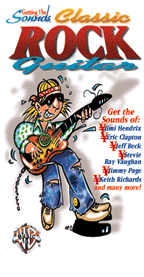
Learn how to get all the great classic rock guitar sounds from the Beatles to Jimi Hendrix, Eric Clapton, Jimmy Page, The Police, and many more. This video will provide you with a complete tonal "menu" from which to select your favorite sounds. 1999 -- $19.95 Music Books Plus. Google Web search.
I have this. -mh
Review
I watched this some time ago. Fast-paced,
polished, relevant. It's perhaps 35% about playing techniques, 55% about gear
types and history, and 10% about gear usage techniques.
Guitar and Amp Tone Video (RPM) (videotape and book)
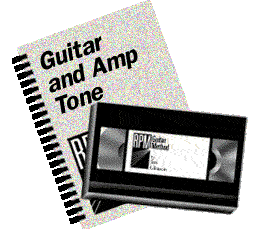
$20 800-678-3738 Rock Performance Music (RPM) - Jim Gleason. 1994. Controlling the balance of preamp distortion and power tube saturation. Be sure to study the substantial booklet as well as watching the video. Thinking in terms of the eq curves for pickups, speakers and cabinets. RPM
"Make the best use of your guitar, amp & new technology to get classic guitar tones of Clapton, Hendrix, Stevie Ray Vaughan, Van Halen, Satriani, Metallica, Beatles. Includes new MP-2 & JMP1 settings. 2 hours, 54 page manual. $20."
I have this. -mh
Review
This video covers about a third of what guitarists need to know about amp tone principles, alternating eq/distortion stages, power attenuators, inductive loads, and low-pass speaker simulators.
Often the mic sounds too far from the cabinets.
Some slow-paced filler or Reference material that's hard to use in practice.
Doesn't cover mic placement or reverberation. This video doesn't cover power tube types. Doesn't cover the difference between eq before saturation vs. eq after saturation.
No mention of power attenuators, understandable since the excellent Hot Plate came out just around that time and people (wimpily and uncritically) had simply assumed that no power attenuator could possibly sound any better than the Scholz Power Soak -- that is, with more bass and treble sent through to the speaker, and more midrange power routed to the dummy load.
Page 53 covers the
Page 22 has sections "Distorting the Power Amp" and "Using Power Amp Distortion". The author is superior here: he literally tells how to dial-in and search for the ratio of preamp distortion and power tube distortion. It's unusual to see practical, specific, and intelligent usage instruction about actually dialing-in amp tone.
The book is good for striving to show specific amp settings and eq curves.
Relatively good EQ coverage, integrating EQ with pickups, amps, and speakers. How to use EQ to compensate for (these days we'd say "model") different pickups and speakers. This approach is headed in a useful direction. It's informative but annoying when the tone/gear instruction videos "educate you" about getting tone by demo'ing rare gear. What real guitarists really need is instruction on how to bend one amp to emulate another.
- mh
The Bonehead's Guide to Amps (book)
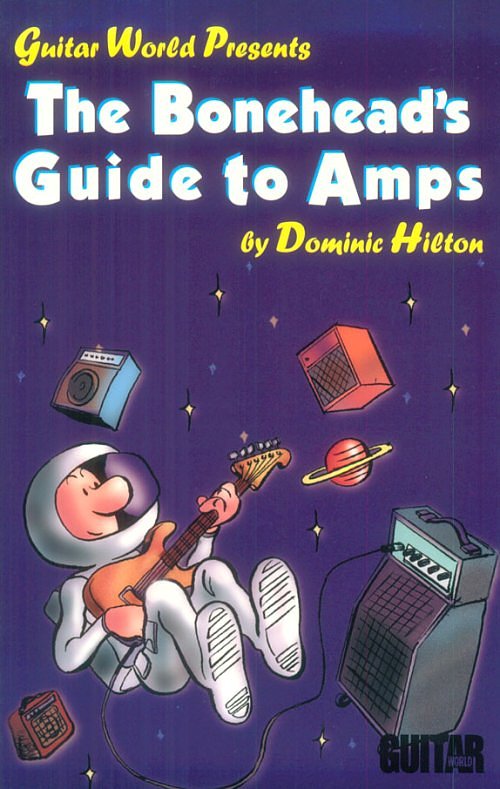
Dominic Hilton. Types of amplifiers, tone-tweaking for styles, adjust your amp for a range of tones, use its functions, price range and requirements, maintain amps. 2000. 80 pages. Music Books Plus. Amazon (sample pages).
"For many novice players their amp is the boring, functional part of their first set-up. This guide explains how it can be as exciting, inspirational and as important as their guitar. Viewing the amp as an instrument in its own right, this book defines both the fundamental and subtle differences between many types of amplifier, while offering valuable info on "tone-tweaking" every kind to suit different styles. Learn how to adjust your amp for a whole range of different tones and how to use its functions to maximum effect. The text also explains how to choose the right products within your price-range and requirements, and how to maintain amplifier equipment for safe and reliable use. By taking an objective and comprehensive view of available guitar amps, this book offers the best bang-for-buck advice to getting killer tones easily, affordably and blasting at the right level. If you want to get your guitar cooking, then make sure it has the right ingredients with this invaluable guide."
I have this. -mh
Review
Mentions guitar speaker distortion on page 20, portraying power amp and speaker distortion as "an essential ingredient for guitar amps".
Mentions "amplifier circuitry and speaker overload", p 22. Page 26 mentions power amp distortion, and a power mode (1/2-power) switch, and shows a photo of the Marshall PowerBrake: "Powerbrake, which is a heavy-duty volume control capable of absorbing the power of a flat-out amp to deliver the same tone at a lower volume..." This is the ideal, not the reality; many people hold that the THD Hot Plate is more transparent than the Marshall PowerBrake, but both products have a characteristic EQ response that manifests even with just a few dB of attenuation, and in addition, heavy attenuation inherently drives the guitar speaker differently, with less roundness and complexity, and this in turn affects the power-tube response. It's odd that the author doesn't mention the Hot Plate, which is often favored over the PowerBrake, given that page 61 shows a photo of a guitarist (Carl Verheyen?) with gear that includes a THD Hot Plate, low in the rack, behind the mic stand.
The book doesn't mention other solutions to the loudness problem including London Power's Power Scaling, the Peale Power Sag technology, and speaker isolation cabinets, and doesn't mention that the power reduction switch is 1/4-power on many amps, nor does it propose using truly low-wattage tube power amps such as 5 watts down to a fraction of a watt.
Page 76 mentions the problem of integrating a guitar preamp/processor with a tube amp, but doesn't have any specific advice; it leaves the reader dangling with a vague recommendation to do "judicious reprogramming" and "serious tweaking and comparisons", rather than providing useful insight and practical guidance.
From the start, this series makes a potentially fatal mistake of separating without integrating guitars, amps, and effects. The "getting guitar sounds" books make more sense for those whose goal is to look at the combination of guitar, amp, and effects as a way of producing a target sound. How does a single-coil neck pickup, through a slow phaser, into a distorted tube power amp sound?
- mh
Recording Guitar and Bass: Getting a Great Sound Every Time You Record (book with CD)
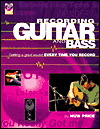
Huw Price. Book with CD. Oct 2002. ISBN: 0879307307. Paperback, 192pp. Publisher: Backbeat Books. Creating a home studio space, choosing and using amps and microphones, processing and enhancing sound with effects, recording acoustic and electric bass, guitar, double bass. Interviews with top technicians, producers and musicians. 63-track companion CD covering amplifiers, microphones, positioning within the studio, EQ applications. Glossary. Music Books Plus. Amazon. B&N.
I have this. -mh
Review
I read this in the store. No profound secrets or tips about basic guitar amp tone -- how to bend your tube amp toward a desired sound -- were in evidence. Has unusual coverage of guitar speakers and guitar speaker distortion. Strong on recording, not outstanding regarding dialing in a desired amp tone at the guitar speaker using stages of eq and levels alternating with distortion stages. I didn't see mentions of key, much-needed topics such as history of power attenuators, or speaker isolation to address the loudness problem.
- mh
Original Cover and Title
Original cover and title: Recording the Guitar: Getting Great Sound With Every Recording
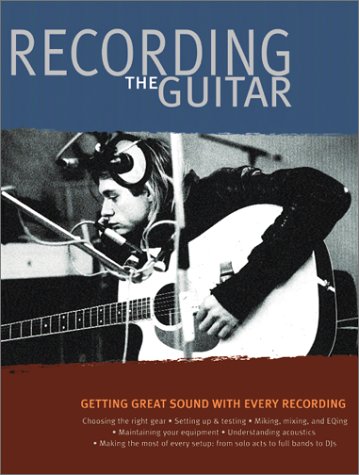
The above is probably the original draft of the cover, with no author name. Found at Amazon jan2003 with same ISBN as purple book. May have had to change title due to Jon Bare's same title, and to make the cover more exciting and broaden audience to include bass and electric guitar.)
Recording Guitars & Guitar Sounds (cassette)
See Music Books Plus. 27 pages, with 60 minute cassette. $21.95. Probably unavailable.
I can't find this. -mh
Recording the Electric Guitar: It's All About Tone (book with CD)
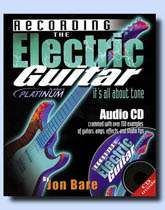
Jon Bare. CD/book. Music Maker Publications. 2001. Jon has written articles in RECORDING, and has played on PLAYBACK, demonstrating equipment and playing with his band The Killer Whales. Getting a good tone to tape or hard disk. Read and hear coverage of guitar types, pickups, amps, mics and miking techniques, eq and effects. Demonstrations of digital amps and guitar simulators. For the recording guitarist and for the recording musician who records guitar players. Playback PLATINUM Series. Search Google.
ISBN 1-893658-04-X
I have this. -mh
Review
The author put much work into the CD. Polished, helpful, and authoritative, the CD uses actual song examples from the author's projects. The book is much shorter than the book The Recording Guitarist: A Guide for Home and Studio, which lacks a CD but has all effort put into the book rather than splitting the effort between creating a book and CD.
Pages 21 and 23 mention speaker distortion.
Page 24 has the most bizarre sentence: "Don't forget to experiment with the tone controls on the amp." That's like saying "Don't forget to step on your new distortion pedal to turn it on." This is an example of the author completely mis-characterizing the audience, missing connecting with the audience, it seems to me. However, that might just seem like a bizarre statement to me because I'm so heavily EQ-oriented; I wouldn't think it so odd to remind guitarists to develop good sounds for all pickups, which amounts to "Don't forget to use your pickup selector switch." This paragraph about the tone controls of a guitar amp would be a great place to systematically explain pre-distortion EQ versus post-distortion EQ.
Page 44 has the usual near-miss where the author virtually discusses the difference between pre-distortion EQ and post-distortion EQ by talking instead about placing a wah pedal pre- or post-distortion. "You may also want to take a look at the guitarist's chain of effects boxes to see where the wah wah is along the chain. Wah wahs sound different and behave differently when placed before a fuzz box than they do when placed after it. When placed before a fuzz box, the sound and range of the wah sweep will be less pronounced due to the compression effect of the fuzz. If you're not careful, this can sound pretty muffled. When placed after the fuzz box, the wah sounds more natural, but it tends to exaggerate the fuzz box's thin highs and deep lows at the extreme ends of its range."
Page 53 has a good list of the EQ stages throughout a standard processing-chain, but doesn't explain the basic, essential, and key difference between pre-distortion EQ and post-distortion EQ, with respect to preamp distortion or power-tube distortion.
Chapter 4 is about multi-miking, and this book provides outstandingly specific and detailed coverage of the options at the mixer and at the guitar speaker cabs. It doesn't have a clear tip to keep the head in the control room and multimike remote cabs.
Page 65 mentions the Lexicon 284 2x3-watt amp with cab-sim filter.
The author waffles on who his audience is: recording engineer or guitarist. This may just be my preference or touchiness as a home guitarist alienated from the world of pro studios, but it's annoying, distracting, alienating, and stiff. "If the guitarist wants to get a thicker sound, have him...". The best book on this count is The Recording Guitarist. As an advocate for guitarists at home, I want to see practical books that are firmly aimed at the guitarist who wants to control sound at the guitar speaker and at their monitor speakers or headphones.
The author should forget about his association with the recording magazine audience and firmly stand within the world of guitarists -- recording guitarists, not guitar-recording engineers. This audience confusion seems to reduce the relevance of the book. Recording Guitarist is awesome in this respect: it's weak on some points, but is basically grounded deeply and practically in the stance and world-outlook of the guitarist; it screams out relevance, with the ability to relate as one recording guitarist *to another* -- not to some hazy engineer who is maybe working with a guitarist.
Like today's other books about guitar recording, this has good coverage of how to capture or use the existing sound of a guitar rig, with less insightful information about how to dial-in a guitar rig to produce a target sound at practical volume levels with a limited amount of gear. The latter is more within the scope of the "getting guitar sounds" books such as Getting Great Guitar Sounds: A Non-Technical Approach to Shaping Your Personal Sound by Michael Ross, and Getting Your Sound: The Player's Guide to Guitars, Amps, and Effects by Tobias Hurwitz.
Recording the Guitar: Get a Great Sound Onto Tape (book)

John Harris. $23.50. 1997. 156 pages. "Avoid spending ages getting that great guitar sound, then after putting it on tape, having it sound like a wet string flapping limply in the breeze. The author is a guitarist and recording engineer. A collection of valuable tips to help you get stunning results from your recordings. Setting up, strings, intonation and playing techniques. When to mic up, when to DI, and when to do both. Diagrams illustrate a range of different mic positions to coax the sweetest sounds from your acoustic. How different pre-amps -- valve, transistor, digital -- can be used for different sorts of music. How to put your masterpieces with effects -- compression, reverb, delay, gating, flange, chorus, harmonizers and more. setting up your guitar; electric and acoustic guitars; mic'ing for acoustic guitars; DI and speaker simulators; using preamps; improving your sound with effects; MIDI for guitarists; production tips and tricks." ISBN 1-870775-45-7. Music Books Plus. Amazon.
I have this. -mh
Review
This is a fine book for capturing an existing amp sound. This book would benefit by being more emphatically aimed at the guitarist, particularly the guitarist who wants good amp tone in a home recording studio. There are currently two other books about recording the electric guitar. The book The Recording Guitarist by Jon Chappell has a more relevant perspective and is the longest, with the greatest number of helpful tips. Recording the Electric Guitar: It's All About Tone by Jon Bare is the same length as the present book, but comes with a CD that carries great authority by using real examples from the author's projects.
Page 2 shows isolation booths/rooms.
Page 7 mentions the loudness problem, and presents -- like all the books -- speaker simulators as the main solution to the loudness problem, without considering various forms of power attenuation or speaker isolation enclosures.
Page 43 has a paragraph on "speaker overdrive".
Page 44 covers re-amping a recorded dry guitar. (This is also an efficient way to dial-in amp sounds, surpassed only by having one person play guitar and the other person operate the processors such as EQ and level settings throughout the processing chain.)
Pages 45 and 50 cover multimiking, which is important when a single person in a home studio wants to remote-mike a guitar speaker and efficiently dial-in a good sound at the mixer.
Page 57-58 has fair coverage of DI (direct inject of a line-level guitar signal into the mixer), together with the muddled coverage of dummy loads, and speaker simulators that is typical in the first wave of "getting guitar sounds" books. "A speaker simulator provides a dummy load in the form of a power soak." That's incorrect and nonsensical. A better statement would be "A typical speaker simulator product provides an artificial speaker load in the form of a resistive or reactive load, in addition to a cabinet-simulation filter." What's happening here, in this sloppy and overgeneral use of the term "speaker simulator" and "power soak", is that the authors of the books have in mind a particular product they aren't explicitly discussing: the Palmer PDI-03 Speaker Simulator, which happens to comprise a dummy load and a cab-sim filter.
The term "power soak" is incorrect as a type of device, especially as a type of dummy load. The product, the Scholz Power Soak, is a power attenuator, which can be used as a dummy load and contains a dummy load together with a wattage splitter. Odd, the author capitalizes "speaker simulation... the Simulator" -- supporting my contention that he ought to explicitly tell us he's talking about the Palmer PDI-03 Speaker Simulator. We need to be rigorous in distinguishing between particular products and general types of circuits or gear. Much of the confusion comes from using product names in place of technology types, and vice versa, as if saying "A Dummy Load is a type of hot plate." These authors totally jumble the product and technology terms: Hot Plate (THD), Power Soak (Scholz), PowerBrake (Marshall), Speaker Simulator (Palmer), Red Box, dummy load, power attenuator, speaker simulator, DI box, and cabinet-simulation filter.
Pages 62-63 almost cover pre-distortion EQ: "the Sans Amp PSA 1... uses EQ pre and post overdrive to allow a very wide range of sounds. ... Alesis Quadraverb GT... EQ section offers almost too many options! ... You also have the option of running the EQ section pre or post pre-amp." The latter choice, "pre or post pre-amp", reflects the industry-entrenched single-EQ fallacy, on the part of the author or Alesis; the right "choice" is both pre and post distortion; a Rock amp rig largely comprises a series of alternating eq and distortion stages. The book mentions Session Award JD10 (also known as the Morley JD10). Page 67 says "a better eq could be patched in ... pre or post overdrive" -- but there is no explanation, systematic or otherwise, of the difference between EQ before the preamp distortion (pickup EQ) and after the preamp distortion (amp EQ). Neither does the book compare EQ before the tube power amp (this is "amp EQ", controlling the power-tube distortion voicing) versus after the output transformer (speaker and mic EQ).
Page 137 half-insightfully says to play the guitar in the control room, with remote miked guitar speaker in the live room, but doesn't specify whether the guitar amp head is in the control room or in the sound room with the miked guitar speaker -- other books point out the tremendous advantages of using a head in the control room and a guitar speaker cab in the live room (or, to speak more meaningfully in a home studio context: using a tube power amp in the mixer room and a remote-miked guitar speaker in another room or enclosure).
- mh
The Recording Guitarist: A Guide for Home and Studio (book)
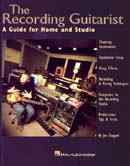
Jon Chappell. Mentions the idea of cabinet isolation boxes/rooms/hoods (and speaker emulators, load boxes) several times. $20 list. 8 1/2 x 11". 1999. 200 pages. Hal Leonard, publisher. Music Books Plus. Amazon.
I have this. - mh
Review
If you can only get one book about using guitar gear to dial-in a sound, get this one. There are more tricks, and there is much more relevant and helpful advice here, than the other books, CDs, or videos. This book is outstanding for its *relevance* -- the author is One Of Us; he knows the problems we face and tricks to help solve them; his thinking style is solidly grounded in the same reality of the typical Rock guitarist at home. He knows who he is writing for. The book oozes relevance and practicality.
The author doesn't know about using a power attenuator as a power attenuator -- only and always as a dummy load. He says to try EQ before distortion, but never shows, like the BOSS booklet, literally running an eq>dist>eq pedal chain or putting an eq before the amp and another in the fx loop.
Among all the books, there are only a couple paragraphs that say anything at all about power attenuators (used as power attenuators). This omission, repeated in this book, is odd, given that most of the "getting guitar sounds" books mention the importance of power-tube distortion.
This
book, like the others, doesn't usefully combine solutions, like combining the
idea of a separate head and cab in control room and sound room with the idea of
a speaker isolation enclosure. This book talks about putting a combo amp
in an isolation box, where you're using the combo amp's power amp, but it's far
better to use a head in the control room -- using only the speaker of the boxed
combo amp.
No existing book shows the important, basic, and fundamental processing chain: guitar pickup EQ, preamp distortion, amp EQ, tube power amp, power attenuator, guitar speaker/mic EQ. That standard omission, where instead these pieces are scattered across the chapters, shows how far we are from having relevant instructional books about using gear for amp tone.
This book has a few brief paragraphs covering: speaker isolation boxes, remote miked guitar speaker, multimiking, pre-distortion EQ, using FX loops to split gear into two modules and recombine, direct inject of a preamp signal into a tube amp's power amp, importance of power-tube distortion, dummy loads, re-amping recorded dry guitar through a guitar amp, and active pickups.
In all the books about using guitar gear to get guitar sounds, I put sticky-tabs marking key, rarely covered aspects of amp tone gear usage. Most books ended up with about 10 tabs, but this book has around 50. The coverage indicated by each tab I inserted is usually very rudimentary; when I say that a tone secret tip is mentioned on a certain page, in most cases I mean that it is just barely touched on, with a couple garbled sentences, lacking systematic coverage. This book has five times as many useful tone tips, or 5 times as thorough coverage of such tips. All these tone tips are fundamental and elementary, really, and should be explained to all beginning guitarists; although these are now considered "advanced gear and amp tone secrets", they should actually be the first thing learned.
- mh
100 Superstar Guitar Sounds on a Stompbox Budget (DOD Presents) (book with CD)
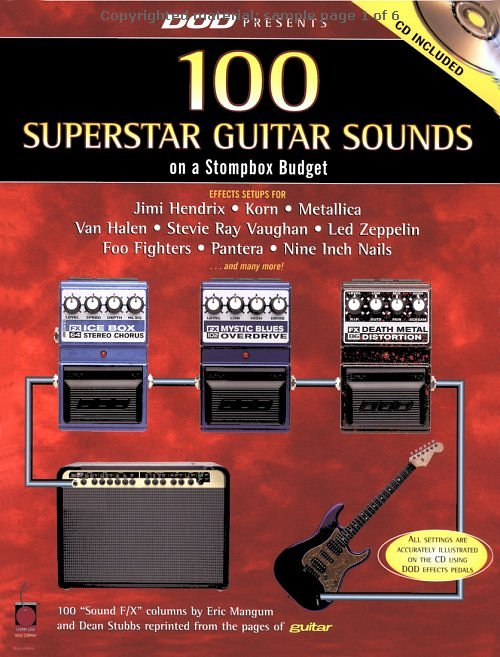
Eric Mangum, Dean Stubbs. "Learn how you can use affordable effects pedals to duplicate the sounds of rock's greatest guitarists. Straight from the "Sound F/X" columns in Guitar magazine are the effects settings and setups for great songs from artists such as AC/DC, Jeff Beck, Eric Clapton, Foo Fighters, Jimi Hendrix, Korn, Led Zeppelin, Metallica, Nine Inch Nails, Pantera, Pink Floyd, Joe Satriani, Van Halen, Stevie Ray Vaughan and many more. Each effects setting is accurately illustrated on the accompanying CD using DOD pedals." December 2000. 128 pages. $19.95. Amazon (sample pages).
I want this. � mh � I was unthrilled in the store but I need to check whether I have this and get it if I don't.� It would be instructive to critique the flaws in these rigs and explain why they don't work satisfactorily, and predict the flaws, and instruct what to do to supplement/dial-in the rigs in the books.
87 Superstar Guitar Sounds on a Stompbox Budget (book)
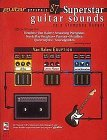
Eric Mangum, Dean Stubbs (Contributor) / Paperback. From Guitar magazine. 1995. Amazon Price: $14.95. 110 pages. Amazon. Music Books Plus. From the magazine Guitar for the Practicing Musician. How to use effects pedals to duplicate the sounds of rock's greatest guitarists. Includes guitar setups of such artists as Beck, Clapton, Hammett, Hendrix, Johnson, Malmsteen, Rhoads, Satriani, and Van Halen.
I don't have this; I want the 2nd edition. -mh
Review
Review comments from looking at this a couple times in the store:
I need to take another look at this in a store to see if there is more than the obvious hookup instructions: "how to plug pedals into an amp". Does it explain the truly basic knowledge about eq>dist and power attenuators, running a miked speaker cab in a separate isolation booth, and so on? The first step I'd do is lay this groundwork for tube-amp based amp-tone modelling: eq>dist>eq>guitaramp>powerattenuator>GuitarSpk>mics>mixer, then insert special-fx pedals. For example, look at the cover diagram -- it's bound to produce a 3rd-rate Van Halen sound, at best, compared to the more authentic chain, 50% phaser>eq>dist>eq>powertubes>dummyload>eq>delay>ssamp>gspk>mics>mixer. The book -- like almost all books -- shows how a beginning guitarist would try ineptly to reproduce a star's sound.
This is a beginner's book in the bad old paradigm, because it's time for a paradigm change in which chapter 1 of a beginner's book to guitar gear shows eq>dist>eq>powertubes>powerattenuator>guitarspeaker>mics>mixer>monitors. What is the right way to start a beginner's book about superstar sound on a stompbox budget? First, buy a tube amp, two EQ pedals, and a power attenuator. A good beginner's book would lay out the ideal chain above and then look at budget compromises.
- mh
BOSS Compact Pedal Application Video (videotape)
"Seven of the hottest instructors from the Guitar Institute of Technology, including Roland technician Paul Hanson, demonstrate how BOSS compact pedals can be used while playing different genres of music - from country to rock to the blues. Complete with some of the tastiest chops around." 38 min. BOSS product videos (dead?) -- Item #BOSS-DEMO. $5.00.
I have this. - mh
BOSS Compact Pedal CD (CD-ROM)
Boss product CDs (dead?)- BOSS Compact Pedal CD (Item #3202) $5.00. "All the latest information on BOSS compact pedals is a mouse-click away as you navigate this innovative CD-ROM. Learn how BOSS' extensive line of guitar effects can give guitarists any kind of sound imaginable. The disc is both Mac- and PC-compatible and can also be played as a standard audio CD."
I have this. - mh
The free booklet, now with CD, may be more effective, offering better fidelity of sound and image than the pixellated and compressed CD-ROM format.
Official BOSS pedals page (dead?)
BOSS Pedal Zone (dead?)
Unofficial Roland GP-100 Web Site - Includes a patch archive and mailing list archives.
BOSS GT-3 Demonstration Video (videotape)
"The GT-3 Demo Video shows you how BOSS took 32 classic and cutting-edge guitar effects and an extremely flexible COSM-based preamp and placed them in a sturdy, compact pedalboard with an ultra-affordable price tag. If you've never heard the Slicer or Auto-Riff effects in action, trust us, they're worth the price of admission alone." (15 min.) GT-3 DEMO VIDEO (Item #GT-3DEMO) $5.00. BOSS product videos. (dead?)
I have this. - mh
Effects and Settings: A Complete Guide to Getting the Best Sounds from Your Effects Equipment (book)
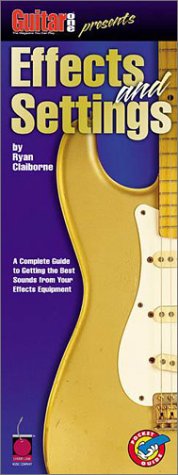
Ryan Claiborne. Other title: Effects and Settings: A Complete Guide to Getting the Best Guitar Sounds from Your Effects. Tall/narrow format. 32 pages. $6. Ryan Claiborne. Cherry Lane Music Company. Hal Leonard Corporation, distributor. From Guitar One magazine. 1999. Elderly. Amazon. Music Books Plus. Search Web. ISBN 1575601613
I have this. -mh
Review
Provides typical, conventional, and unremarkable coverage of guitar effects. It is noteworthy for relatively pointed emphasis on pre-distortion eq, as far as preamp distortion goes: page 7, 9 top, 12 and 13, 32.
Feels like a mid-1990s book written during the era of the "tube = preamp tube" fallacy and of the fancy guitar preamp/processor era.
Doesn't touch on interaction with the amp: no coverage of how the tone stack affects power tube distortion, no mention of power-tube distortion, or power attenuators, or speaker distortion. Doesn't integrate eq with amp tone or amp response. Not really helpful for getting a good *amp* tone, such as interaction of phaser and a cranked amp. Provides basics about effects that are so generic, it might be talking about processing any instruments, while overlooking some truly basic things about Tone, especially principles for shaping distortion tone through multiple stages (preamp, power amp, guitar speaker).
- mh
Getting the Sounds: Classic Guitar Effects (video or DVD)
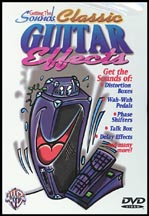
Nick Nolan. "Nick Nolan will teach you how to get the best sounds from today's electronic guitar effects. Includes how to set-up and adjust wah-wah pedals, phase shifters, chorus, delay, reverb, flanging, compression, and more. Includes tips on chaining effects together, how to use an effects loop and how effects relate to the recording process." Video is ISBN 0-7692-6501-4. $19.95. Warner Bros. Stagepass.com. MusicToyz.com. Web search.
I have this. -mh
Guitar Effects Guide Book (BOSS) (book with CD)
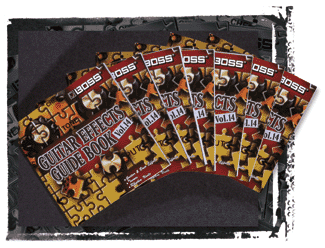
In 16th edition, Jan 2003. Includes audio CD corresponding to the booklet. CD-size booklet, 80 pages. Free at the BOSS display in guitar gear stores.
Compare "The BOSS Book: The Ultimate Guide to the World's Most Popular Compact Effects for Guitar".
I have this. -mh
Review
This is the only guitar amp-tone related book that shows not only a single eq pedal before a distortion pedal, but a distortion pedal bracketed by two eq pedals. This booklet doesn't commit the single-eq pedal fallacy that reigns in all the other amp tone and fx books and in all the guitar magazines.
Contains important tips and less-common useful pedals such as LS-2 line switcher. Shows interesting chains.
- mh
Guitar Player Oct 1992: The Distortion Issue (magazine)
The Grunge & The Glory: A Celebration of Distortion. Distortion/Tone Tips from the Loud & Mighty. Decoding Distortion: What It Is and How It Works. Fuzz Tone User's Guide: 31 distortion pedals. Rats in the Cellar: gallery of classic grunge. Dialing for Distortion: sound advice from producers.
I have this. -mh
Read it if you can.
The Bonehead's Guide to Effects (book)
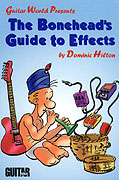
Dominic Hilton. Hal Leonard. $10. 79 pages. 1999. From Guitar World. Use effects to create a personalized sound with color, depth, character, and texture. Understanding the world of effects -- wah, flange, fuzz or octaver. Definitions of types of effects and when they are most appropriate. What to look for when purchasing effects, how to take care of the effects, and creating different sounds with effects. 6" by 9". guitarspot.
I have this. -mh
Review
Mentions or shows effects including the SansAmp Classic, Yamaha DG-1000 rackmount amp simulator guitar preamp, Roland VG-8, Rocktron Hush, Tube Driver distortion pedal, Morley JD10 D.I. distortion box.
Mentions using a guitar amp's FX loop on p 56, and the challenge of combining a preamp/processor with an amp on page 57.
Page 61-64 has valuable wisdom about testing used gear (I bought two pieces of gear that turned out to be broken).
There are no real amp tone tricks here -- nothing about pre-dist EQ, phaser before distortion, EQ and distortion interaction, and no mention of power attenuators or dummy loads, essential non-amp items in many rig processing chains of the 90s through the present.
This book is good, but makes all these standard mistakes of omission -- pedestrian and conventional; a decent inventory of the obvious, it won't help you dial in a basic amp tone voicing. It isn't really helpful in integrating effects into a practical foundation of amp tone, such as examining the fundamental chain of amp tone: pickup EQ, preamp distortion, amp EQ, power-tube distortion, power attenuator, speaker/mic EQ.
The distortion section says nothing about combining stages of distortion, or the relation between preamp distortion and power-tube distortion. It doesn't mention shaping distortion voicing by pre-distortion EQ. The EQ section says nothing about pre-distortion EQ versus post-distortion EQ; it says nothing but the totally obvious. The Phaser section says nothing about where phasing can be placed, before or after a distortion stage. Same with the Volume Pedal section.
These effects sections don't integrate the effect within a rig chain, but that's one of the most important things guitarists should know. It's rather obvious, by demoing pedals in the store, what each effect does on its own -- we really don't need a book for that, so in this sense, the book is superfluous and doesn't add value. The issue of effects order is covered in a vague and helpless way on page 71 -- "different pedals behave very differently depending on their order". Do people buy this book just to be told what they already know? No, they need specific advice, but the book doesn't have any, just "try it" -- tellingly, page 72 starts with an implicit admission of the lack of content in the book's main sections regarding effects placement: "Instead of letting you leave empty-handed, it only seemed fair to offer some old family recipes for the road."
The book is basic in the wrong way; it could have presented 80 pages of insight and tricks for integrating various processors with a distorting tube power amp, comparing different sequences, and showing how to manage the loudness problem. Instead, it's an inventory of the obvious. Let's hope the next generation of guitar effects books studies the better, more professional-level books such as The Recording Guitarist.
- mh
The BOSS Book: The Ultimate Guide to the World's Most Popular Compact Effects for Guitar (book with CD)
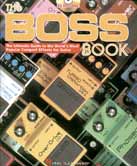
Story and details of every Boss compact effect ever made; color photos, design history, trivia, tricks, secrets. Interviews with the Boss founder and design engineers. Essays on musical trends and famous players. Accompanying CD features 72 guitar sounds with control settings and detailed equipment set-ups. 122 pages, paperback. How Overdrive differs from Distortion: tables, graphs, large number of oscilliscope snapshots shows how an OD1 differs from and OD2. Covers the main effects and some at several settings. $19.95. JK. Elderly. Amazon.
Paperback: 124 pages ; Dimensions (in inches): 0.31 x 10.30 x 8.36. Publisher: Hal Leonard Publishing Corporation; ISBN: 063404480X; Book & CD edition (January 2002).
Compare "Guitar Effects Guide Book (BOSS)".
I want this. -mh
60s Psychedelic
Guitar (videotape with insert)
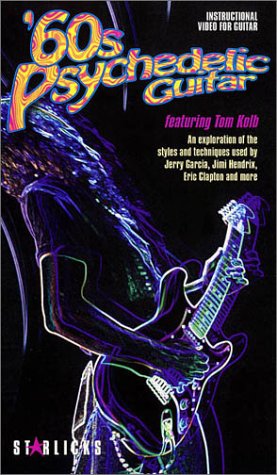
Hal Leonard Publishing Corporation; ; (November 1998) ISBN: 0793594898 "Musicians Institute instructor Tom Kolb provides insights into the playing styles of '60s guitar greats Jerry Garcia, Jimi Hendrix, Eric Clapton, Jorma Kaukonen, Syd Barrett and others. He demonstrates psychedelic effects such as wah-wah, fuzz, reverb, echo, tremolo and phasing, and goes into detail about how each player used these devices. He shows guitarists how exotic-sounding scales are created by mixing minor pentatonic, harmonic minor and blues scales with Phrygian, Dorian and Mixolydian modes. Tom also covers techniques such as sitar licks, vibrato bar, bottleneck slides, droning string licks, open string licks, atonal licks, bends and vibrato, arpeggios and more. Includes a booklet featuring easy-to-follow notation and diagrams that correspond exactly to the video." Amazon.
Insert: 32-pages of printed music showing licks and styles of stars, matching what's shown in the video.
I have this. - mh
Review
Preliminary review comments - I watched about the first 1/2 hour of this. It appears to be 85% about playing techniques, and 15% about gear usage techniques.
-- Michael Hoffman
Get that Classic Fender Sound! (videotape with insert)
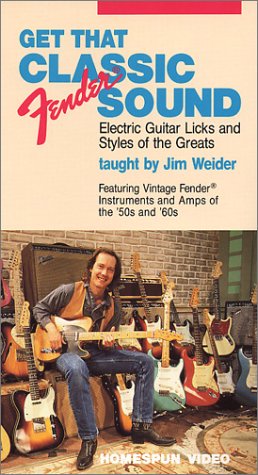
Jim Weider (The Band). 90 min video and music/tab book. 1990. Licks, tips on tone, amp settings, and little-known facts about the instruments and players. Play the classic electric guitar licks. Lick-by-lick instruction covering Roy Buchanan, James Burton, Steve Cropper, Robbie Robertson, Jimmy Vaughn, Jimi Hendrix, others - how they got their distinctive sounds. Jim has a collection of original instruments, recreating the music on exact models of the amps and guitars. Includes amp settings, picking techniques and other data of interest to all electric guitarists. Homespun Tapes.
Google Web search for this video - Available at: Fender for $29.95. Available for $39.95 at the following locations: Homespun Tapes, Amazon, JK, ActiveGuitar, WholeNote, LightHouseMarket.
I have this. -mh
Review
This 1990 video is around 65% about playing techniques, 25% about gear history, and 10% about gear usage techniques. It was good to hear different pickups. Most playing is with completely clean tone, though most Rock guitarists are interested in distorted as well as clean sounds, including preamp distortion, power-tube distortion, and speaker distortion. This video does cover Fender amps but covers them as they were used in the eras they were designed.
Despite the assumptions and expectations of today's retro amp and gear enthusiasts who were inspired by Stevie Ray Vaughn, the video isn't about how you can use your guitars, effects, amps, and related gear to get the classic Fender sounds; it's about how to play particular vintage Fender guitars with particular vintage Fender amps to get the "album sounds" that were popular during the respective vintage eras.
When asked about the problem of getting the sounds of these amps, because these amps are unavailable, Weider only reassuringly asserts that you can get the sounds, and the new amps can get the sounds -- he doesn't say how, in practical terms. Like many of the instructional books and videos about amp tone, this video tends to present and show off a heap of vintage amps rather than telling you how to effectively use your existing amp to emulate them.
The books thus come across as promoting purchase of a large number of particular products; they seem designed to exacerbate and whip up Gear Acquisition Syndrome, and rare-gear lust, rather than providing you with mastery of concepts and practical, specific skills of dialing-in your existing gear.
In this day of the collapse of the record industry and the switch from pro recording studios to home recording, it would be particularly helpful to cover swapping pickups, tubes, and speakers, together with pre-distortion EQ and amp mods and power attenuators, to address the real-world problem of how to get classic Fender sounds under extreme volume constraints and under the constraints of having limited gear.
Most people who might be interested in
getting classic Fender sounds -- or rather, getting the sounds of classic
Fender gear used so as to bring out desired Tone -- aren't denizens of a pro
studio that is soundproofed and stocked with an array of vintage Fender guitars
and amps. So in practice, this video teaches about the history of gear and
playing styles and how they developed together. It leaves you to try to bridge
the gap from that historical perspective to today's gear and today's
home-studio environment.
The insert is 17 double-video sized pages with printed music, matching what's shown in the video.
Getting the Sounds: Classic Blues Guitar (videotape)
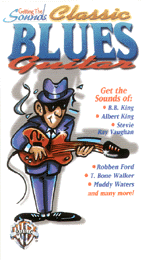
Warner Brothers. Keith Wyatt, master Blues guitarist and educator, demonstrates how to create the soulful sounds of all the great legends of the Blues guitar. From classic hollow-body sounds to the sustain of modern solid-body guitar, the colorful history of Blues sounds and techniques are covered by Keith in detail. Includes tips on how to choose and then "dial in" amplifiers and guitars for maximum effect. Keith also demonstrates several classic Blues licks and rhythm patterns as performed by the masters. It's all about "Getting the Sounds! Get the Sounds of: B.B. King, Robben Ford, Albert King, T. Bone Walker, Stevie Ray Vaughan, Muddy Waters ... and many more. 1998. VHS -- $19.95 Music Books Plus. Google Web search.
I have this. -mh
Review
Fast-paced, polished, relevant. Keith Wyatt is a great, energetic, affable, yet no-nonsense presenter -- a model instructor. I watched this video some time ago; seems about 60% playing technique, 30% gear history, and 10% how to use gear.
Getting the Sounds: Classic Country Guitar (videotape)
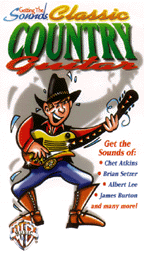
Country guitar sounds, from shimmering "clear as country water" sounds to driving rockabilly. 1999. Music Books Plus. Amazon.
I have this on DVD.
Review
Little about amp tone, but fitting and interesting coverage of Compressor, Volume, and Delay pedals in conjunction with playing techniques. Completely clean amp tone throughout. Perhaps 75% playing technique, 15% gear history, and 10% how to use gear.
- mh
Getting the Sounds:
Hot Nashville
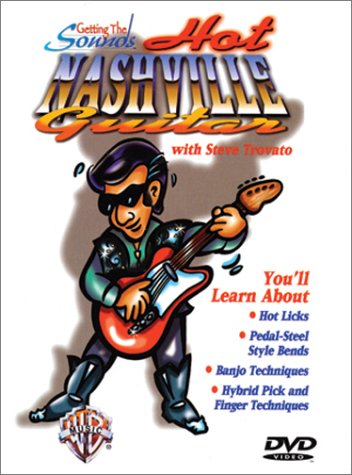
I want this. - mh
Painting With Guitar (videotapes)
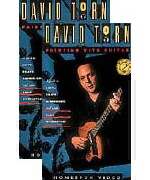
David Torn. Two Homespun video tapes covering how to use delay-based effects, colors, sound washes, orchestral effects, and other sonic alternatives. (Torn has used the ADA Ampulator, a power-tube saturation "pedal" (single-space rackmount), and has raved about it. I wonder if he mentions it here.) Homespun Tapes. Amazon, video 1. Amazon, video 2. 1993. $30 each.
I have video 1.
Review of Video 1
OK or good. It's about effects usage, not amp tone. More emphasis on effects usage than playing techniques. -mh
The Guitar F/X Cookbook (book with CD)
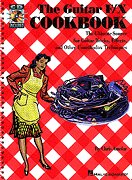
By Chris Amelar. 1996. Book/CD pack. Demonstrates and explains 45 incredible guitar sounds using common stomp boxes and a few unique techniques. Sounds include pick bowing, B-3, police siren, crazy slide, sitar, church bell, tribal drums, mad elephant, monkey screams, feedback, race car, gargling, and kaboom. ISBN 079356509X. Available at Music Books Plus. Amazon (sample pages).
I have this. -mh
More about playing techniques than fx gear.
Covers the same kind of sounds as the Tricks and Special Effects book with CD, but Cookbook has a really well-done, great-sounding, interesting CD that is actually enjoyable to listen to, and is drawing me to the book, and to the videotape with insert.
The Guitar F/X Cookbook (videotape with insert)
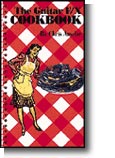
By Starlicks. 1997. $19.95. How to create a myriad of guitar sounds and effects ranging from useful imitations of other instruments (such as sitar, banjo, koto and steel drums), to animal noises and bizarre sonic mutations, using common stomp boxes and a few unusual techniques. Music Books Plus. Musicroom.com. Amazon.
Insert: 40 pages, mostly text, with some diagrams and some printed music.
I have this. -mh
More about playing techniques than fx gear. The well-done CD raises hopes for the value of this video.
The Wah Wah Book (book)
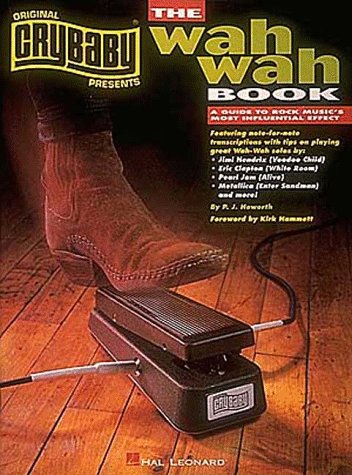
History, philosophy, product information, 9 note-for-note transcriptions of famous solos and over 30 pages of playing tips. Featured artists: Jimi Hendrix, Eric Clapton, Kirk Hammett (Metallica), Mic McCready (Pearl Jam), Eddie Van Halen, and many others. ISBN 0793532345. From CryBaby. Music Books Plus. March 1994. Amazon.
I want this. -mh
Tricks and Special Effects (book with CD)
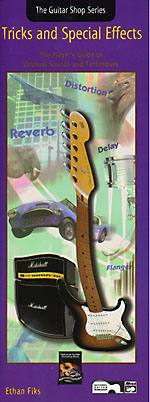
"Make your guitar scream like an elephant, meow like a cat, or sound like a seagull. Imitate a sitar, a cello or a racecar. This book includes a wide variety of special guitar tricks described in detail with exact effects settings and photographs. Also included are sections on the physics of sound and the functions of common effects pedals. The included CD demonstrates all the sounds." (c)1998, 48 pages. Book & CD. ISBN 0-88284-958-1. Part of the National Guitar Workshop's "The Guitar Shop Series". Feb 2000. Music Books Plus. Barnes & Noble. National Guitar Workshop.
Ethan Fiks has published Tricks and Special
Effects: The Player's Guide to Unusual Sounds and Techniques, which is part of
the Guitar Shop Series. Ethan teaches in
I have this. -mh
This is about special effects in playing style (not mainly effects as in effects pedals), augmented by special effects from effects pedals. Tricks that can be used for flash guitar or shred. About 75% playing techniques, 25% gear usage techniques. No coverage of basic amp tone.
Covers similar effects as the Guitar F/X Cookbook.
The Stompbox (book)
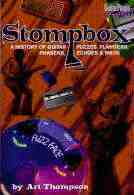
Art Thompson. Pictures of vintage stompboxes, and stories from their creators. Evolution of effects. Stories of the manufacturers. A history book set mainly in the 1960s and 70s. Interesting fact: the first Tube Driver (aka Real Tube) distortion pedal, with an actual preamp tube, was offered in ads in Guitar Player in 1979 -- that early. I thought I was one of the first buyers, around 1987. I was glad to read that the Ibanez Tube King is actually made by the Tube Driver designer. He has a patent on a tube distortion pedal using a 9 volt supply to drive the preamp tube at over 200 volts. 1997. Music Books Plus. Amazon (sample pages).
This is a gear history book, not a gear usage book.
I have this. -mh
Writing Style
Assume reader knows all the conventional things from ads, mags, online, stores, brochures. Discuss the foundation while assuming they know the common, obvious basics. Treat items briefly, start with the meat. Provide a short introduction, then get right to business with intermediate to advanced substance that is technical in a practical way for gear users.
Using Pre-Dist EQ
Controlling Basic Amp Tone with EQ, Distortion, and Power Attenuation
Pre-distortion EQ for Every Distortion Stage
Two EQ Pedals and Power Attenuator as a Standard Foundation
The EQ Effect and Its Relation to Distortion Voicing
EQ and Distortion Voicing: Alternating EQ and Distortion Stages
How to Dial-in Pre-Distortion EQ
Distortion pedal voicing, multi-voiced pedals, and the Akai eq>dist>eq pedal
How to Determine whether an Amp's Tone Stack Is Pre- or Post-Distortion
Owning Multiple Overdrives, Distortion Pedals, and Amps
Classic Pedals Implemented Dubiously via Digital Delay
Mapping Out Pure Notes on a Guitar Using Distortion
Using Power Attenuators
Power Attenuator Features and Usage
Cabinet-Simulation Filters, Power Attenuators, and Dummy Loads; Speaker Simulators, Load Boxes, and DI Out
Passive EQ of the Speaker via Power Attenuator Load Splitting
Using a Power Attenuator as a Dummy Load
EQ'ing the Speaker Using a Dummy Load
Solutions for the Loudness Problem and Their Tradeoffs
Using Guitar Speakers
Cab-Sim Filters: Pros and Cons
Isolation Boxes, Isolation Booths, and Iso-Cabs
Swapping Out Pickups, Tubes, and Speakers
Using Two Combo Amps as a Separate Head and Remote Miked Cab
Combining Separation of Head/Cab, Remote Multi-Miked Cab, Isolation Box, and a Power Attenuator
Using Feedback and Reverb with an Isolated Speaker
Manually Modelling Amp Sounds
Manual Amp Modelling Using Two EQs and a Power Attenuator
Reamping for Tone-Cloning
Sharing Libraries of Dry-Guitar Files and Reamped Results
Reamping for Circuit and Rig Design
Bringing Two EQs and a Power Attenuator into the Store
Full Integration of Tubes and Modelling: VOX Valvetronix, Fender CyberTwin/CyberDeluxe, Johnson Millenium
Analog and Hybrid Modelling of Amps: SansAmp, Peavy analog modelling amps
Power-Tube Distortion
Using a Power-Tube Distortion Pedal Like Any Distortion Pedal
Forming a Power-Tube Distortion Pedal from an Amp and Dummy Load
Switching between Sounds
Using Switchers to Controlling Guitar Processing
Using Multiple Amps Onstage
Switching When Using Dummy Loads with Multiple Amps
Switching from Crunch with Power Attenuation to Clean w/o Power Attenuation
Processing Chains
Interleaving Processor Halves With Amp Halves for Programmability
Putting Effects after the Power Amp Using a Dummy Load or the Mixer
Multiple Phasers Before and After Distortion
How to Blend Phaser, Wah, or Other Effects with Dry signal
Using Phaser, EQ, Wah, or Talkbox Pre-Distortion
Combining a Preamp/Processor with a Tube Amp
Future Products Needed
Understanding of These Is Needed Throughout the Industry
Distortion with Pre-Dist EQ (Akai, Rocktron)
GUI Programming of Standalone Hardware
Delay with Tape Dropouts, Treble Control, and Multitap Outputs with Even Level
Power-Tube Distortion Pedal
Compact Tube Amp with Integrated Power Attenuator or Power Scaling
Power Scaling in Tube Amps
9-Band Compact EQ Pedals
Compact Amp with Modelling, Tube Power Amp, and Dummy Load or Power Attenuator or Power Scaling
Passive EQ Integrated with Power Attenuation
Footswitch-Controlled Levels of Power Attenuation
Multi-Voiced Power Attenuators
Tube Amp Modif. Selector Switch
[other items from my virtual-store page]
Index Entries/Glossary Entries:
cabinet-simulation filter
cab-sim filter
compression:at each stage
compression:power-tube
compression:speaker
distortion voicing with eq
distortion:mixer
distortion:power tube
distortion:preamp
distortion:speaker
dry-guitar file
dummy load
eq pedals:multiple
eq:for distortion voicing
eq: before distortion
eq:after power tubes
eq:in pickups
eq:in speakers
eq:programming multiple stages to switch together
fx loop:breaking amp or processor in half
Guytron amp
Hot Plate
load box
mixing:effect pedal with bypass signal
power attenuator
power/volume relation
power-tube distortion
power-tube distortion pedal
pre-distortion EQ
quasi-clean distortion
reamp
SansAmp
speaker distortion
speaker simulator
switching:between amps
switching:when using power attenuator or dummy load
VOX Valvetronix
voicing:distortion
Resources
Online Product Reviews and Discussion
Books about Getting Guitar Sounds
Online Resources about Amps, Effects, and Guitar Recording